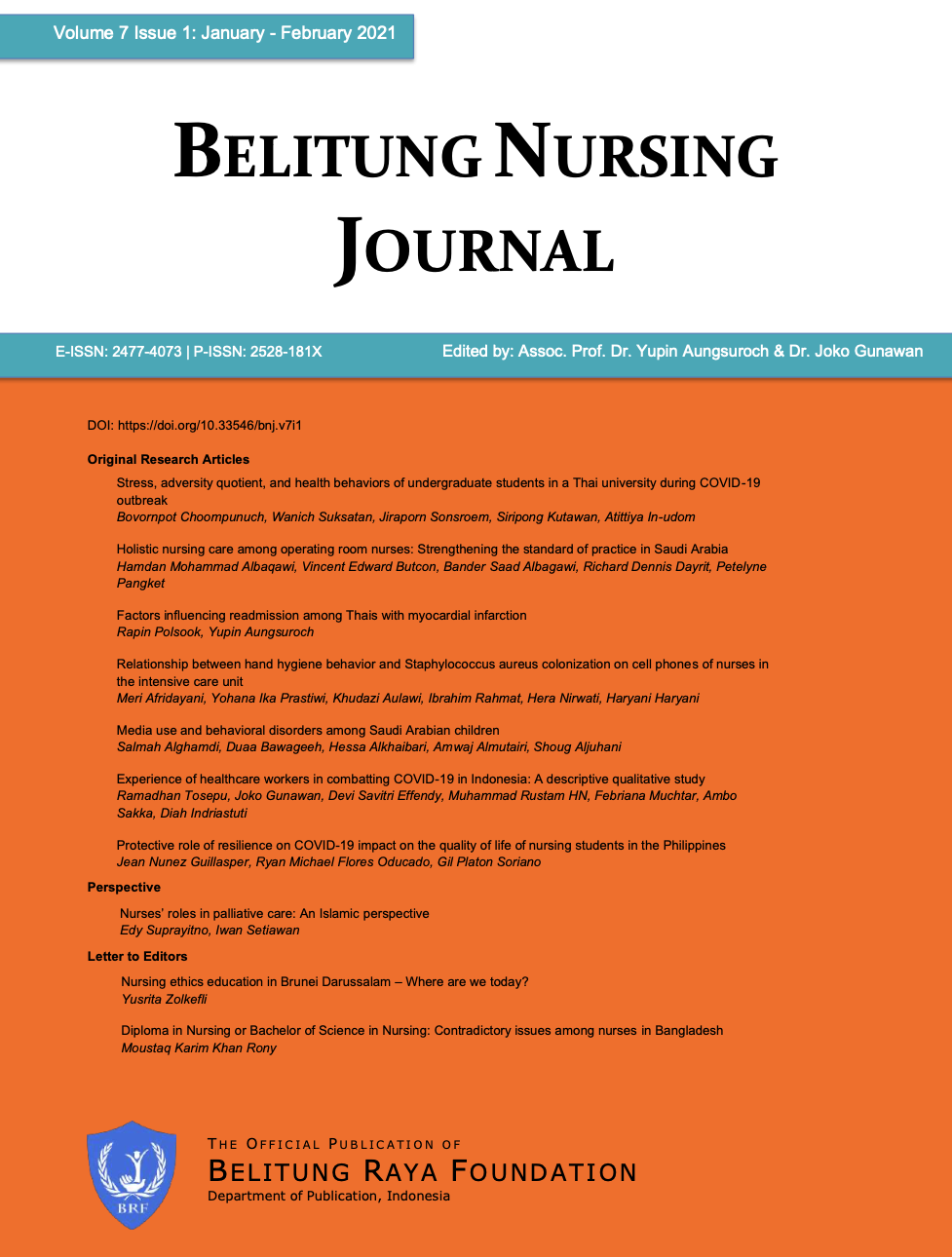Coronavirus Disease 2019, or called COVID-19, was first reported in Wuhan, China, on 31 December 2019, and it has spread across the world (World Health Organization, 2020). World Health Organization (WHO) has announced COVID-19 as a pandemic on 11 March 2020. As of 28 January 2021, 219 countries and areas were involved, with 101,433,090 confirmed cases, 2,184,120 confirmed deaths, and 73,320,448 recovered (Worldometer, 2021). In Indonesia, as of 28 January 2021, there are 10,242,298 confirmed cases, with 164,113 under care, 831,330 recovered, and 28,855 confirmed deaths (Ministry of Health, 2021). While COVID-19 is continuing to spread, each country and its communities must make efforts to prevent further transmission and reduce the outbreak's impacts (Tosepu, Effendy, & Ahmad, 2020).
Many countries have decided to lockdown, but Indonesia might be doubtful to do the same considering many factors, including business and economics. As a consequence, Indonesia is still struggling with new cases every day. In responding to the outbreak, health professionals are at the first line, and they are sacrificing their lives and put them at risk of infection (Gunawan, Aungsuroch, et al., 2020; Tosepu, Effendy, Lestari, et al., 2020). It is undebatable that their works are significant to save people's lives, particularly for those with COVID-19. However, the capacity of hospitals and the number of health workers are not in line with the number of cases that continue to rise. They are demanded to work extra while people are recommended to stay at home (Gunawan, 2020; Ketphan et al., 2020).
Given the importance of the roles of healthcare workers in the battle of COVID-19, this study aimed to explore how their experience in handling the cases, either with positive cases or suspected ones. There is no such study discussing this topic. Therefore, this study will provide the input and reference to decrease the incidence rate of COVID-19 and, importantly, to appreciate healthcare professionals' hard efforts in this battle.
Methods
Study Design
This was a descriptive qualitative study conducted in April 2020.
Participants
The participants were purposively selected to explore more information regarding their experience in taking care of persons with positive COVID-19 or those still under control. The inclusion criteria of participants were all healthcare workers involved in the battle of COVID-19 in Indonesia.
Data Collection
The respondents were contacted through a short message service (SMS) and phone call. Once they accepted the invitation, an appointment was scheduled for an online interview. The online semi-structured interview was conducted using the Indonesian language by principal investigators for approximately 30-60 minutes. The question guideline was prepared prior to data collection.
Data Analysis
In this study, a thematic analysis was used for data analysis. Thematic analysis is a qualitative research method for identifying, analyzing, organizing, describing, and reporting themes found within a data set (Braun & Clarke, 2006). Thematic analysis is a useful method for examining the perspectives of different research participants, highlighting similarities and differences, and generating unanticipated insights (Braun & Clarke, 2006).
Ethical Consideration
The ethical approval of this study was obtained from the Research Ethics Committee, Indonesian Public Health Association (IPHA), with approval number: 115/KEPK-IAKMI/IV/2020. Prior to data collection, the researchers explained the objective and the procedures of the study to the participants. It is also described that this study was voluntarily, which the participants could withdraw from the study at any time without penalty. The researchers in this study confirmed that each respondent had obtained appropriate informed consent. The researchers also guaranteed their data confidentiality and ensured them that their information would be published anonymously.
Trustworthiness
To ensure the trustworthiness of this study, we discussed among researchers and experts to ensure that there was no bias in analyzing and developing the themes. All researchers were agreed with all findings. Member checking was also done to validate the results, as it is the most critical technique to establish credibility (Gunawan, 2015).
Results
Characteristics of the Participants
Thirteen respondents were included in this study, which consisted of four medical doctors (30.7%), three nurses (23.1%), three public health practitioners (23.1%), one midwife (7.7%), one member of the surveillance team (7.7%), and one health analyst (7.7%). The average age was 36 years. The majority of the respondents were females (53.85%) than males (46.15%). The participants were working at East Luwu Regency South Sulawesi, Konawe Regency Southeast Sulawesi, and Papua. Of all participants, ten participants (76.9%) were married, and three participants (23.1) were single. Eight participants (61.5%) were working at hospitals, four participants (30.8%) were at public health centers, and one participant (7.7%) was at the Department of Health.
Analytical Findings
Eight themes emerged from the data. Each is explained in the following:
Theme 1: Lack of Personal Protective Equipment (PPE)
The majority of respondents agreed that there was a lack of personal protective equipment, especially facial masks, and protective clothing. This is explained in the following statements:
PPE is still limited in our workplace (p3)
We have a lack of PPE based on a standard to take care of patients with COVID-19 or those who are under evaluation (p9)
Theme 2: Lack of referral hospitals and limited facilities
Most respondents agreed that there is a limited number of referral hospitals appointed by the Government of Indonesia. In addition, the existing hospitals have limited infrastructures. This is explained in the following:
Too limited referral hospitals appointed by the government to deal (p6)
Referral hospitals exist, but with inadequate facilities. For example, in intensive care units, the beds and ventilators are limited (p5)
In terms of infrastructure, we have not enough quality and quantity; for example, ventilators, intensive care units, and the number of health workers are also limited (p2)
Theme 3: Dealing with patients with unknown status
The majority of respondents said that they most likely dealt with unknown status, which put them at risk of infection. Besides, many patients did not tell the truth about their conditions, traveling histories, and previous contacts. The respondents said:
In the emergency unit, many patients who come but have not yet found out whether they were positive or not, but they were positive eventually. Try to imagine our situation, and we were without PPE or less than the standard to serve these patients (p12)
Once the patient has shown symptoms of COVID-19, which has been served by nurses, then an examination is carried out, and it turns out positive, which eventually nurses are contaminated and infected with COVID-19.
Patients were most likely dishonest with health workers about traveling or from a pandemic area (red zone) because of fear of being said to be people under observation. They were also dishonest if they have a history of contact with patients with positive COVID-19 and the symptoms. One patient was also dishonest that he had been examined at another hospital and was positive but refused to be treated.
Theme 4: Feeling worried about getting infected or being a source of viral transmission
The majority of respondents felt worried due to the lack of protective equipment. They were also worried that they would bring the virus to their homes and infect the family. It is explained in the following:
This is the dilemma of medical staff who is in direct contact with patients. We must be anxious that we may bring “gift” from the hospital to family at home (p2, p10)
Concerned about the potential for this patient to transmit to others and themselves, worry about the patient's prognosis and the clarity of the patient's diagnosis because, in this place, the facilities are very minimal (p4)
Worried to be infected (p8)
Feeling worried because PPE is very limited (p9, p10, p11, p12)
Theme 5: Being creative
Due to a lack of PPE, healthcare workers are demanded to be creative. Some modified the masks, and some were wearing raincoats for their protection. It is explained in the following:
We can modify it by using alternative PPE even though the protection strength is not as good as the standard PPE (p2)
We still use a raincoat as a personal protector (p3, p8)
Yes, we use the raincoat at the public health center when we meet patients (p7)
Theme 6: Too long shift and fatigue
Some respondents thought that their shift is too long due to the spread of the virus is very fast. The other said that they felt uncomfortable wearing the protective clothing for such a long time. The respondents said:
An eight-hour shift is dangerous because, in the current situation, the risk of contracting COVID-19 is very high (p5, p10)
During an outbreak, I think this 8-hour shift is dangerous because the transmission of COVID-19 is very fast, and we do not know who is infected (p7)
Eight hours is too long; considering the discomfort when using PPE, it should be even shorter (p4)
Nurses work hard because of the many patients they serve. They feel fatigued, finally, their immunity drops, and the possibility of contracting COVID-19, which then they need to have isolation with positive status and eventually died (p12)
Theme 7: Being surrender to God
As all health professionals are at risk of being infected, all agreed they remember God, pray, and give all things to the Creator. The respondents said:
We just pray and zikr, remembering God that we will return one day (p1)
We do our best, and everything cannot happen without the will of the Creator (p4)
I am being surrendered to God; it is our job to save lives (p8)
Theme 8: Government Issues
All respondents had given the critics or inputs to the government related to the policy, massive test, PPE, and physical distancing. It is explained in the following:
Underestimating the pandemic (p2)
Too slow in deciding a policy (p2)
The government cannot conduct massive tests to detect as many cases as possible for early treatment (p2)
The government cannot meet the PPE needs of medical personnel (p2)
The government has failed to control the prices of PPE that are sold at unreasonable prices (p2)
The government failed to limit the visit of foreign nationals from the beginning before COVID-19 became a pandemic (p2)
Our society seems to ignore the social/physical distancing (p2), so we all need to emphasize all elements of society to do physical distancing (all respondents)
Discussion
This study aimed to explore the experiences of healthcare workers in combatting COVID-19 in Indonesia. Eight themes emerged from the data, which were discussed in the following:
The theme lack of PPE is related to the personal protection of healthcare workers, especially for medical doctors and nurses who provide direct care to the patients. This theme is in line with a study by Gunawan et al. (2021). However, personal protective equipment is very important to protect the mucosa - mouth, nose, and eyes from droplets and contaminated fluids. The hands are known to transmit pathogens to other parts of the body or other individuals. Hand hygiene and gloves are very important in protecting health workers and preventing transmission to others (Juthamanee, 2020). Face masks, protecting clothes, and headgear are also considered important to prevent transmission to healthcare workers (Tosepu, Gunawan, et al., 2020).
The theme lack of referral hospitals and limited facilities indicates that the number of referral hospitals for COVID-19 is limited if seen from the increased number of positive cases every day. In addition, several hospitals appointed by the government to handle the COVID-19 outbreak are now in the public spotlight. Not because of the satisfying service, but because of inadequate facilities. Some government hospitals have isolation rooms with small capacity and close screening services. This is in line with Marison (2020) said that there were six patients with suspect COVID-19 in a small isolation room in a hospital. A distance of two meters, called the safe distance to prevent the spread of the virus, is not applied in this room. In fact, some patients ended up using a wheelchair and sleeping on the floor without getting a mattress.
Under the theme dealing with patients with unknown status, it indicates two missing points: there is no rapid test at the regional hospitals to find out the initial status of the patients quickly, so it is too late to anticipate the transmission of the virus to medical personnel. Second, many patients were not honest about their history of travel to the red zone (infected area) and COVID-19 symptoms. As a result, many doctors and nurses died from COVID-19. This patient dishonesty is due to misunderstanding and stigma that have arisen in the community (Gunawan, Juthamanee, et al., 2020).
The theme feeling worried about getting infected or being a source of viral transmission is understandable. Being health personnel who provides direct care to patients with COVID-19 requires caution, accuracy, focus, and always be vigilant. It is not impossible they can be infected and even transmit to others, especially families at home (Gunawan, Juthamanee, et al., 2020; Visagie, 2020). Worry is also closely related to the first and second themes, which are related to the lack of facilities.
The theme being creative is the response to the lack of facilities in hospitals—many nurses, doctors, and other medical personnel use raincoats to protect them. Salute for creativity, but sad if thinking about the risks. Besides, the theme too long shift & fatigue indicates that doctors, nurses, and other medical personnel are also human beings who need rest to enhance their immunity (Gunawan, Aungsuroch, et al., 2020). Eight hours shift with many patients and a high level of focus and alertness requires extra energy. So that hospital managers need to increase the number of available staff or shorten the shift schedule to reduce the risk of COVID-19 transmission to medical staff.
The theme being surrender to God indicates that the healthcare workers believe every human will die in due course. Treating patients with COVID-19 has many risks, but apart from that, we can only surrender to God and believe that God will always protect our family and us. Surrender does not mean weak, but rather a combination of effort and prayer for the best of humankind. It is considered one of the coping mechanisms among them.
The theme government issues indicate the government's unpreparedness in dealing with the pandemic, making the people's anxiety and emotions begin to increase. The government policy in dealing with the spread of the COVID-19 pandemic has not successfully decreased the transmission rate. It is not only about the lack of facilities, but also about the inconsistency to make decisions to do a massive test, limit the entrance of foreigners, and maximize the prevention in the community. Besides, the Ministry of Health policy regulates the COVID-19 National Referral Laboratory can only issue examination results. This has made it difficult to identify and potentially hide the seriousness of the problem. Therefore, more disclosures were found to be infected with COVID-19 after the victim died. The government also needs to disclose information, including the location of infected patients and travel history, while still ensuring the protection of the personal data of patients. It is also necessary to ask the government to clarify the mechanism and effectiveness of mass tests and not impose their costs on the people. Apart from the role of the government, it also needs to be emphasized that battling COVID-19 also needs the part of the community, especially in implementing physical distancing, because a lot of our people seem to ignore it (Tosepu, Gunawan, et al., 2020).
The implications of this study include the need for additional PPE for health professionals, especially for nurses and medical doctors who make direct contact with patients, and the addition of the appointment of referral hospitals with complete facilities. It is also necessary to increase the number of health workers immediately to reduce fatigue that puts them at risk. The sample in this study might not represent the whole context of healthcare workers in Indonesia, which only involved several health professions. The settings of the study were also not representing the whole Indonesian context. Therefore, further study is needed with a bigger and equal sample size and equal settings to generalize the findings among the healthcare workers.
Conclusion
Eight themes were emerged from this study related to the lack of PPE and infrastructure, psychosocial problems, creativity, fatigue, and the roles of the government in handling COVID-19 in Indonesia. The results of this study can be input to the government to be more active and decisive in making decisions and pay more attention to human life than other interests.









